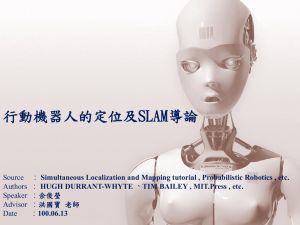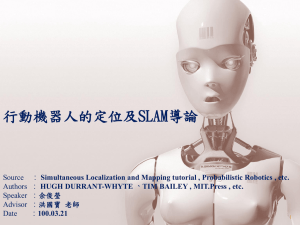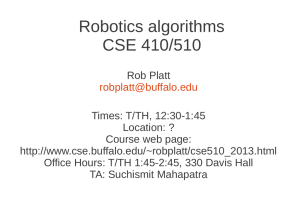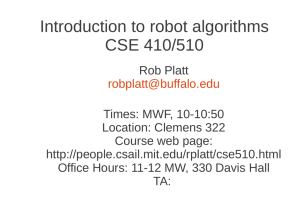Introduction to SLAM Simultaneous Localization And Mapping Paul Robertson
advertisement
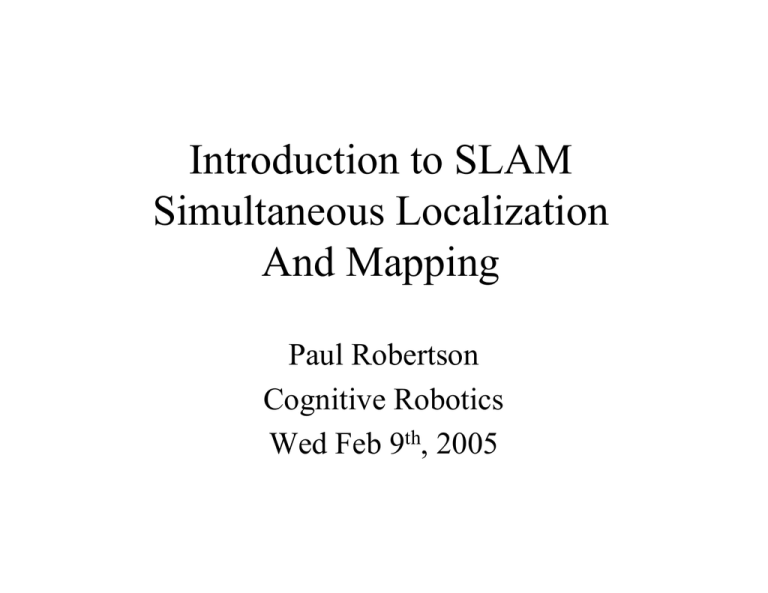
Introduction to SLAM
Simultaneous Localization
And Mapping
Paul Robertson
Cognitive Robotics
Wed Feb 9th, 2005
Outline
•
•
•
•
Introduction
Localization
SLAM
Kalman Filter
– Example
• Large SLAM – Scaling to large maps
2
Introduction
• (Localization) Robot needs to estimate its
location with respects to objects in its
environment (Map provided).
• (Mapping) Robot need to map the positions
of objects that it encounters in its
environment (Robot position known)
• (SLAM) Robot simultaneously maps
objects that it encounters and determines its
position (as well as the position of the
objects) using noisy sensors.
3
Show Movie
4
Localization
• Tracking
Tracking
– Bounded uncertainty
– Can flip into kidnapping problem
• Global Localization
Global
Localization
– Initially huge uncertainties
– Degenerates to tracking
• Kidnapping Problem
– Unexpected global localization
Kidnapped
5
Representing Robots
Position of robot is
represented as a triple
consisting of its xt, yt
components and its
heading θt:
xi, yi
u t∆ t
θt
xt+1
Xt=(xt, yt, θt)T
xt
Xt+1=Xt + (ut∆t cos θt, ut∆t sin θt, ut∆t)T
6
Kalman Filter Localization
Robot
Landmark
7
Kalman Filter Localization
Robot
Landmark
8
Kalman Filter Localization
Robot
Landmark
9
Kalman Filter Localization
Robot
Landmark
10
Basic SLAM
• Localize using a Kalman Filter (EKF)
• Consider all landmarks as well as the robot
position as part of the posterior.
• Use a single state vector to store estimates
of robot position and feature positions.
• Closing the loop allows estimates to be
improved by correctly propagating all the
coupling between estimates which arise in
map building.
11
Initialize Feature A
C
B
A
12
Drive Forward
C
B
A
13
Initialize C
C
B
A
14
Initialize B
C
B
A
15
Drive Back
C
B
A
16
Re-measure A
C
B
A
17
Re-measure B
C
B
A
18
Basic EKF framework for SLAM
x=
xv
y1
y2
.
.
.
,
System State Vector
P=
Pxx Pxy1 Pxy2 …
Py1x Py1y1 Py1y2 …
Py2x Py2y1 Py2y2 …
.
.
.
.
.
.
.
.
.
Covariance Matrix (Square, Symmetric)
x and P grow as features are added to the map!
19
SLAM steps…
1. Define robot initial position as the root of the
world coordinate space – or start with some preexisting features in the map with high
uncertainty of the robot position.
2. Prediction: When the robot moves, motion
model provides new estimates of its new
position and also the uncertainty of its location –
positional uncertainty always increases.
3. Measurement: (a) Add new features to map (b)
re-measure previously added features.
4. Repeat steps 2 and 3 as appropriate.
20
The Kalman Filter
Features:
1. Gaussian Noise
2. Gaussian State Model
3. Continuous States
4. Not all state variables need to be observable.
5. Only requires memory of the previous estimate.
6. Update is quadratic on the number of state
variables.
21
Updating state estimate with a
new observation
1. Predict current state from the previous
state estimate and the time step.
2. Estimate the observation from the
prediction.
3. Computer the difference between the
predicted observation and the actual
observation.
4. Update the estimate of the current
state
22
Vector Kalman Filter
gain
Y(k) +
G(k)
Y(k)
-
correction
+
X(k)
estimate
+
C
ACX(k-1)
T
A
AX(k-1)
measurement parameter
delay
system parameter
current prediction
G(k) = AP(k|k-1)CT[CP(k|k-1)CT+R(k)]-1 (Predictor gain)
P(k+1|k) = [A-G(k)C]P(k|k-1)AT+Q(k)
(Prediction mean square23error)
Matrix newMeasurement (Matrix measurement, double ts)
{
Matrix matP1=null; // variances of components of prediction
Matrix cvecE=null; // residual error
Matrix cvecY=null; // estimated input
double timeDelta=ts-pts; // Establish system matrix for time duration since the last observation.
matA=matAorig.add(matStime.scalarMultiply(timeDelta));
matAt=matA.transpose();
// Predict the new state at the given time step
cvecX=matA.mul (cvecX);
// Measurement prediction- estimate of input
cvecY=matC.mul (cvecX);
cvecE=measurement.subtract(cvecY);
// Calculate Kalman gain matK
matP1=matA.mul (matP).mul (matAt).add(matQ);
matK=matP1.mul (matCt).mul (matC.mul (matP1).mul (matCt).add(matR).invert());
// update the error covariance matrix
matP=matP1.subtract(matK.mul (matC).mul (matP1));
cvecX=cvecX.add(matK.mul (cvecE));
// Correct
pts=ts;
return matC.mul (cvecX); // return estimated values
24
}
Simple Example
Robot with estimated position (Px, Py) and
estimated velocity (Vx, Vy). Four state variables
( Px, Py, Vx, Vy )T
Relationships between the state variables:
Px += tVx
Py += tVy
Observations: (Px, Py)
Position variance (σp) = 100.0
Velocity variance (σv) = 0.1
25
System Equation
Px (k+1)
Py (k +1)
=
Vx (k +1)
Vy (k +1)
X(k+1)
1
0
0
0
0
1
0
0
T
0
1
0
A
0
T
0
1
Px (k)
Py (k) +
Vx (k)
Vy (k)
X(k)
0
0
σv
σv
w(k)
26
Observations
Px (k)
Py (k)
Y(k)
=
1 0 0 0
0 1 0 0
C
Px (k)
Py (k) +
Vx (k)
Vy (k)
σp
σp
X(k)
v(k)
=
Px
Py
Measurement Covariance Matrix =
σp
0
Observation Matrix Y(k)
0
σp
27
System Noise
System Noise Covariance Matrix Q(k) =
0
0
0
0
0 0 0
0 0 0
0 σv 0
0 0 σv
28
Prediction Matrices
Initial Prediction Covariance Matrix (P) =
State Equations (A)
=
σp
0
0
0
1
0
0
0
0
σp
σp
σp
0
1
0
0
T
0
1
0
σp
0
σpσv
0
0
σp
0
σpσv
0
T
0
1
29
30
Run Kalman Filter Demo Program
31
Problems with the Kalman Filter
1. Uni-modal distribution (Gaussian) often
problematic.
2. Can be expensive with large number of
state variables.
3. Assumes ‘linear transition model’ –
system equations must be specifiable as a
multiplication of the state equation. The
Extended Kalman Filter (EKF) attempts to
overcome this problem.
32
Additional Reading List for
Kalman Filter
Russell&Norvig ‘Artificial Intelligence a
modern approach’ second edition 15.4
(pp551-559).
33
Large SLAM
Basic SLAM is quadratic on the number of features
and the number of features can be very large.
Intuitively we want the cost of an additional piece
of information to be constant.
Lets look at one approach that addresses this issue by
dividing the map up into overlapping sub maps.
Leonard&Newman ‘Consistent, Convergent, and
Constant-Time SLAM’ IJCAI’03
34
35
Location Vector
• The mapped space is divided up into
overlapping sub maps with shared features in
the overlapping sub maps.
T(i, j) = (x, y, θ)T (Location vector)
An entity is a location + a unique ID.
A Map is a collection of entities described with
respect to a local coordinate frame
Each map has a root entity i and a map location
vector T(G,m)
36
37
